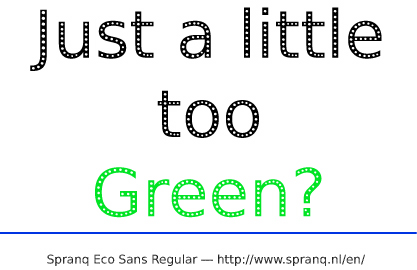
Don’t get me wrong. I’m not against environmentalism. Poor Richard is just as worried about what we’ve done to the planet as the rest of you. And I’m really concerned when it’s 40 degrees on January 1st and 75 on the 2nd. But I think we’re taking the “green movement” a little too far. Right now, I’m remembering the lyrics to an old B.B. King blues song:
I gave you a brand new Ford
and you said “i want a Cadillac”
I bought you a ten dollar dinner
and you said “thanks for the snack”!
I let you live in my penthouse
you said it was just a shack!
I gave you seven children
and now you wanna to give ’em back!
In “How Blue Can you Get?,” B.B. has gone to the extremes for his woman . . . but nothing he can do is good enough for her. ‘Scuse me, but I think we’re taking the environmental thing just a little too far, too. I discovered a new font on the web the other day. It’s called Spranq Eco Sans. Here’s an example:

Spranq Eco Sans
You will note that the font has holes in it . . . small holes that can’t be seen when the type is small (below the blue line); but are visible in the large type. Created by a (very clever) Dutch advertising agency, Spranq, the Eco Sans font is purported to use up to 20% less ink. I’m not really sure how serious Spranq’s initiative was intended to be, but here’s what they say:
The Ecofont is developed by
SPRANQ, based on a hunch of Colin Willems.
With the Ecofont SPRANQ hopes to increase environmental awareness. Some ideas are:
• End-users: print only when necessary, use a modern, efficient printer and use unbleached paper.
• Graphic designers: use modern color separation techniques to avoid unnecessary wastage in ink. In paper choice, take the environment into account.
• (Offset) printers: avoid modern laser techniques that make ink indivisible from the paper. Keep an eye on innovations, such as plant-based ink.
• Printer manufacturers: invest in environment-conscious innovation.
Poor Richard is convinced that the Eco font is fulfilling its purpose. It’s getting Spranq a lot of attention. As to the company’s stated intent, I can’t resist a barely guarded response:
- Print only when necessary. Also, you should only use a bare minimum of toilet paper . . . only as much as is necessary. Staples and Office Depot don’t carry much in the way of unbleached paper, but AlphaGraphics can cut some kraft paper down for you if you would like to run it through your laser printers (or use it in your bathroom).
- Graphic designers, does this mean that you can’t use 300% saturation for blacks any more (C=70, M=70,Y=60,K=100)? More about paper in following paragraphs.
- Offset printers aren’t concerned with laser technologies, but there are no laser/toner/inkjet technologies that do not make the ink indivisible from the paper. Soy based inks don’t dry very well. Also, the dot gain is excessive . . . rendering the holes in the Eco Sans font completely useless.
- Printer manufacturers — I’ll leave this one alone. I’d rather talk about the paper manufacturers.
For some time, AlphaGraphics, Inc. has been championing a chain of custody initiative. It’s called FSC (Forest Stewardship Council). FSC is involved in the certification of timberlands worldwide for best management practices. All well and good. In the U.S., their stated goal is:
to coordinate the development of forest management standards throughout the different biogeographic regions of the U.S., to provide public information about certification and FSC, and to work with certification organizations to promote FSC certification in the U.S. (Source: fscus.org).
Laudable goals. Great marketing. But completely unnecessary in the U.S. For 15 years prior to diving in to a small printing business, Poor Richard was employed in the lumber industry. At one time Poor Richard was actually a board member for the Southern Forest Products Association. From this viewpoint, I can state without reservation that the U.S. timber industry is not the problem.
In 1994, the American Forest and Paper Association started a Sustainable Forestry Initiative setting Best Management Practices and goals for American forests:
a set of forestry principles that would meet the needs of the present without compromising the ability of future generations to meet their own needs. These principles call for a land stewardship ethic which integrates the reforestation, nurturing, and harvesting of trees for useful products with the conservation of soil, air and water resources, wildlife and fish habitat, and forest aesthetics.
Weyerhaeuser Corporation, now defunct, was involved in sustainable forest initiatives decades before the SFI. I will never forget a visit to Mt. Saint Helens in the early 1990s, about 10 years after the eruption. Weyerhaeuser owned most of the timberlands approaching the mountain. They had replanted almost all of the timber that was destroyed by the volcano. They managed the timber they owned in South Georgia in much the same way, as did Union Camp and many other timber companies and private landowners.
Here’s the point: We need to get real about our environmental concerns and about what we actually do (not just what we say we do).
On the AF&PA website, I found the following:
Nevertheless, despite its collective strengths, the industry is under intense cost pressure from foreign competitors. Many foreign competitors are not incurring government regulatory program costs comparable to those in the United States. The industry continues to look for the most efficient and cost-effective ways to improve environmental performance. This means that we will continue to press for regulatory approaches that are cost effective, performance-based and take business cycles into account.
Let’s take this to the microcosm — a small printshop in Macon, GA. AlphaGraphics buys FSC and SFI certified papers. We buy from American mills as much as possible. Most of the remaining American made papers do have some recycled content. We can and do buy a recycled gloss paper from Appleton Papers called Utopia.
But, we also buy an inexpensive gloss text that is imported by our distributors. Some of it comes from China. Why do we buy this stuff? Because we have to. Paper is a significant cost component in most printed products (duh?). Without an economically priced paper option, we would not be able to sell color printing. The FSC certification sound great and it’s a great marketing tool . . . but it doesn’t apply in China. The fiber in this stuff may come from waste paper imported from the U.S. or from the rain forests of Myanmar (Burma). Who knows?
It wasn’t always this way. In days of yore, before the U.S. abdicated our manufacturing crown (regulated and free traded it away), it was possible to buy a variety of domestic papers: in different colors, in different grades, at different price points. Now, many of the remaining U.S. mills are owned by overseas companies and the selection has been reduced to “white ” or “natural” (see Poor Richard’s post “If Counterfeiters are dinosaurs, can printers be far behind?”).
I’m banging the drum again. What the AF&PA advocates is practical, not idealistic. It’s time we get beyond the nonsense of “green” marketing and get back to the critical issue of how we control our own destiny. Selling green is meaningless. Doing green is not. Doing green and competing is even better.
We’ve got our priorities wrong. Like B.B.’s ungrateful lover, we’re dissatisfied with what we don’t have and didn’t earn. Perhaps we also want to regulate the impractical. The U.S. did very well with Fords and ten dollar dinners. We still can. It’s time to make the most of what we have. We have done it responsibly before . We can manufacture things responsibly again. It’s time to get back to work.
Here’s B.B. King, for your listening pleasure:
Vodpod videos no longer available.
 Will this signal a return to the good old days of print on paper? Probably not, but it’s still a very effective (if counterintuitive) argument for valuable products that really shouldn’t be as outmoded as popular environmental mantras would make them. Click on the logo, visit the site, watch the video and let me know what you think. Or better yet, order something printed on paper from the printshop behind the red awnings on Poplar Street.
Will this signal a return to the good old days of print on paper? Probably not, but it’s still a very effective (if counterintuitive) argument for valuable products that really shouldn’t be as outmoded as popular environmental mantras would make them. Click on the logo, visit the site, watch the video and let me know what you think. Or better yet, order something printed on paper from the printshop behind the red awnings on Poplar Street.


 Posted by poor richard
Posted by poor richard 

 It was called “Old Money” for a good reason. Crane Papers of Massachusetts made it, the very same company that made currency stock for the U.S. Treasury for all those years. I had heard all of the stories about printers and counterfeiting, but I guess it never really registered. That was before the order for letterhead printed on “Old Money” came in.
It was called “Old Money” for a good reason. Crane Papers of Massachusetts made it, the very same company that made currency stock for the U.S. Treasury for all those years. I had heard all of the stories about printers and counterfeiting, but I guess it never really registered. That was before the order for letterhead printed on “Old Money” came in.